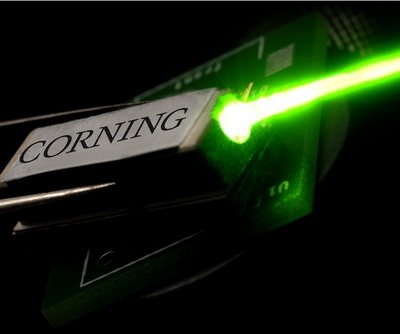Green lasers in action
Green is such a common color in nature, many would be surprised to learn how hard it is to re-create, especially when dealing with light and energy. After decades of trying, there have been several breakthroughs in the past five years in creating a green laser, with many different solutions.
One of the biggest pushers for green lasers was originally the display industry, for use in RGB displays and imaging in order to create vibrant colors in super-efficient, high-definition devices. Red and blue lasers had been accomplished, but green was still just out of reach.
"Green is a challenge," says Clifford Hund, president of Corning International K.K. (Japan). Green wavelengths have been surprisingly hard to create, due in part to the materials used. Most of the efforts to create a green laser have focused on gallium nitride (GaN) crystals to create a controlled laser beam. The problem with GaN is that right around the wavelengths that create green, the crystals distort and essentially neutralize the output of green light.

Several different approaches have been applied to creating a green laser, trying to work around or through the distorted GaN crystal dilemma.
Corning was the first to demonstrate a "synthetic" green laser in 2006. Corning bought the laser development group from Bell Labs 12 years ago, but wasn't exactly sure what to do with all this research power.
"Two years ago, we were not a 'laser' company," says Hund. "We went to our customers and asked, 'Here are our capabilities; what do you need?' Our customers responded, 'We'd love a green laser.' They gave us the start, and we went from there."
A synthetic green laser is created by focusing an infrared laser light through a pair of lenses on a lithium niobate (LN) crystal that transforms them to create a single photon of green light with a wavelength of 530nm. Controlling the beam was accomplished by using adaptive optics. "In this configuration, the two lenses are mounted on separate orthogonal, smooth-impact drive mechanism actuators that are constantly adjusted through a closed-loop operation to optimize green power," writes Vikram Bhaktia in a recent SPIE Newsroom technical article.
A synthetic green laser was also not easy to create, since the GaN crystal can alter the color of the green emitted. The crystals can also heat up quickly and are expensive to keep cool, making it a less than ideal option for working with electronics.
The first direct-emitting diode or "true" green laser was demonstrated in 2009 by both Sumitomo (Japan) and Osram (Germany), by developing a GaN crystal which inhibits the efficiency drop of normal GaN crystals, resulting in room-temperature pulse operation of a laser diode emitting at 531nm. Osram recently reported that it had successfully created continuous-wave (cw) 524nm laser emissions with an output power of 50mW, and wall-plug efficiencies as high as 2.3%. Osram also produced even longer wavelengths (531.7nm) using a pulsed-mode operation.
QDLaser (Japan) demonstrated a green laser in 2009 using quantum dots and a frequency-doubling method.
Making the green laser viable for commercial products has also turned out to be a challenge. Since these lasers were originally developed to be embedded in mobile devices, researchers had to make sure they would work when jostled, heated or chilled. Another challenge was getting the lasers to turn off and on with extreme precision; the kinds of devices that would use the laser operate by switching red-blue-green lasers off and on at 100 megahertz (100 million times per second).
Despite these challenges, the first commercially available laser, Corning's G-1000, was released in 2008, with many more following suit. In this short amount of time, the green laser has found multiple applications, from better TV to astronomy.

"This innovation enabled technologies like pico projectors and microvision," says Cali Sartor, product line manager for the synthetic green laser at Corning (USA). Corning's focus with its green laser has been on pico projectors (see separate SPIE Newsroom article). A laser light source in a pico projector allows for higher bandwidth, higher modulation, up to 150 megahertz, and high resolution in a MEMs scanner. Corning's latest green laser, the G-2000, was designed specifically with the pico projector market in mind. At least half of the power of their 80mW pico projector comes from the green laser, says Sartor.
"We took an ecosystem approach to the market," says Hund. "In this business it's better to develop ecosystems, to find risk-reduced ways of developing. We learned from the photonics industry, and we're taking that and applying it here."
Green lasers have found a surprising variety of niche markets beyond creating high-resolution RGB color. Samsung's Android cell phone, released this year, uses green lasers in its system. Green lasers have been applied to defense and security uses in head-mounted displays and laser guides. Green laser guides are also being used by amateur astronomers for star guiding and tracking. And the applicability of green lasers is growing: Yole Development predicts that the market for indirect-emitting green laser diodes will reach $500 million by 2016.
There may be just as many problems to solve with the green laser as there are ways to create one.
- Adrian Avramescu et al., True Green Laser Diodes at 524 nm with 50 mW Continuous Wave Output Power on c-Plane GaN, Appl. Phys. Express, vol3, p061003, 2010.
- Vikram Bhatia et al., Green light allows big pictures from small projectors, SPIE Newsroom, 2010. doi:10.1117/2.1201002.002636
- http://www.qdlaser.com/news/20090929_PR_eng.pdf
- http://www.pr-inside.com/green-laser-diode-market-size-will-r1940989.htm
- http://spectrum.ieee.org/podcast/semiconductors/optoelectronics/green-laser-update
- Pinhole Cinema: Pico projectors take the floor, SPIE Newsroom, 2010. doi:10.1117/2.2201006.02
